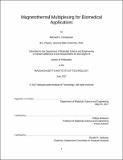| dc.contributor.advisor | Polina Anikeeva. | en_US |
| dc.contributor.author | Christiansen, Michael G. (Michael Gary) | en_US |
| dc.contributor.other | Massachusetts Institute of Technology. Department of Materials Science and Engineering. | en_US |
| dc.date.accessioned | 2017-09-15T14:21:11Z | |
| dc.date.available | 2017-09-15T14:21:11Z | |
| dc.date.copyright | 2017 | en_US |
| dc.date.issued | 2017 | en_US |
| dc.identifier.uri | http://hdl.handle.net/1721.1/111248 | |
| dc.description | Thesis: Ph. D., Massachusetts Institute of Technology, Department of Materials Science and Engineering, 2017. | en_US |
| dc.description | This electronic version was submitted by the student author. The certified thesis is available in the Institute Archives and Special Collections. | en_US |
| dc.description | Cataloged from student-submitted PDF version of thesis. | en_US |
| dc.description | Includes bibliographical references (pages 170-176). | en_US |
| dc.description.abstract | Research on biomedical applications of magnetic nanoparticles (MNPs) has increasingly sought to demonstrate noninvasive actuation of cellular processes and material responses using heat dissipated in the presence of an alternating magnetic field (AMF). By modeling the dependence of hysteresis losses on AMF amplitude and constraining AMF conditions to be physiologically suitable, it can be shown that MNPs exhibit uniquely optimal driving conditions that depend on controllable material properties such as magnetic anisotropy, magnetization, and particle volume. "Magnetothermal multiplexing," which relies on selecting materials with substantially distinct optimal AMF conditions, enables the selective heating of different kinds of collocated MNPs by applying different AMF parameters. This effect has the potential to extend the functionality of a variety of emerging techniques with mechanisms that rely on bulk or nanoscale heating of MNPs. Experimental investigations on methods for actuating deep brain stimulation, drug release, and shape memory polymer response are summarized, with discussion of the feasibility and utility of applying magnetothermal multiplexing to similar systems. The possibility of selective heating is motivated by a discussion of various models for heat dissipation by MNPs in AMFs, and then corroborated with experimental calorimetry measurements. A heuristic method for identifying materials and AMF conditions suitable for multiplexing is demonstrated on a set of iron oxide nanoparticles doped with various concentrations of cobalt. Design principles for producing AMFs with high amplitude and ranging in frequency from 15kHz to 2.5MHz are explained in detail, accompanied by a discussion of the outlook for scalability to clinically relevant dimensions. The thesis concludes with a discussion of the state of the field and the broader lessons that can be drawn from the work it describes. | en_US |
| dc.description.statementofresponsibility | by Michael G. Christiansen. | en_US |
| dc.format.extent | 176 pages | en_US |
| dc.language.iso | eng | en_US |
| dc.publisher | Massachusetts Institute of Technology | en_US |
| dc.rights | MIT theses are protected by copyright. They may be viewed, downloaded, or printed from this source but further reproduction or distribution in any format is prohibited without written permission. | en_US |
| dc.rights.uri | http://dspace.mit.edu/handle/1721.1/7582 | en_US |
| dc.subject | Materials Science and Engineering. | en_US |
| dc.title | Magnetothermal multiplexing for biomedical applications | en_US |
| dc.type | Thesis | en_US |
| dc.description.degree | Ph. D. | en_US |
| dc.contributor.department | Massachusetts Institute of Technology. Department of Materials Science and Engineering | |
| dc.identifier.oclc | 1003289955 | en_US |
